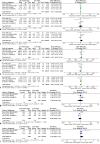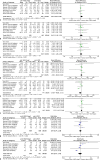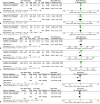Efficacy and Safety of Intravitreal Faricimab in Neovascular Age-Related Macular Degeneration, Diabetic Macular Edema, and Retinal Vein Occlusion: A Meta-Analysis
- PMID: 39362194
- PMCID: PMC11614417
- DOI: 10.1159/000541662
Efficacy and Safety of Intravitreal Faricimab in Neovascular Age-Related Macular Degeneration, Diabetic Macular Edema, and Retinal Vein Occlusion: A Meta-Analysis
Abstract
Introduction: Intravitreal anti-vascular endothelial growth factor (VEGF) therapy has become the mainstay of treatment in many retinal diseases. The comparative efficacy and safety of newer bispecific anti-VEGF/angiopoietin 2 (Ang2) agents in the treatment paradigm versus widely used monospecific anti-VEGF agents remains unclear.
Methods: A systematic literature search of MEDLINE, Embase, and Cochrane Library was conducted to identify comparative observational studies and randomized controlled trials published from 2015 to Jul 2024. With assessment by three independent reviewers, original English peer-reviewed full-text articles evaluating faricimab versus monospecific anti-VEGF agent(s) in FDA-indicated retinal disease with data on at least one set of efficacy and/or safety outcomes for each treatment arm and a minimum 3-month follow-up period were included. Data were appraised using the Cochrane RoB2 and ROBINS-I tools, PRISMA, and Grading of Recommendations, Assessment, Development, and Evaluation (GRADE) guidelines. All outcomes were collected at the last follow-up. Random effects meta-analyses with 95% confidence intervals were conducted to calculate weighted mean differences and risk ratios. Change in best-corrected visual acuity (BCVA, ETDRS letters), change in central subfield thickness (CSFT, μm), and presence of retinal fluid were primary endpoints; ocular adverse events were secondary endpoints.
Results: Across 13 studies, in the context of neovascular age-related macular degeneration (nAMD), diabetic macular edema (DME), and retinal vein occlusion (RVO), 2,226 eyes received anti-VEGF monotherapy and 3,022 received faricimab. Final and change in BCVA were similar between treatment groups. Faricimab was associated with a significantly higher reduction in CSFT in DME and RVO eyes but not in nAMD eyes. The incidence of ocular adverse events was similar between groups.
Conclusion: There was no difference in BCVA between faricimab and anti-VEGF monotherapy in nAMD, DME, and RVO. While faricimab offered superior improvement in CSFT at the final follow-up for DME and RVO eyes, this effect was not seen in nAMD eyes. Future studies are needed to establish the long-term safety and efficacy of faricimab for retinal vascular disease.
Keywords: Age-related macular degeneration; Anti-Ang2; Anti-vascular endothelial growth factor; Diabetic macular edema; Faricimab.
© 2024 The Author(s). Published by S. Karger AG, Basel.
Conflict of interest statement
P.A.H.N., A.M., and A.P. declared no conflicts of interest. M.M.P. received research grant/financial support (to institution) from Physicians’ Services Incorporated (PSI) Foundation and Fighting Blindness Canada. R.H.M. received research grant/financial support (to institution) from Bayer and Novartis and received consultant/consulting fees from Allergan, Bayer, Novartis, and Roche. D.T.W.W. received consultant/consulting fees from Alcon, AbbVie, Apellis, Bausch Health, Bayer, Biogen, Boehringer Ingelheim, Novartis, Ripple Therapeutics, Roche, Topcon, and Zeiss; is an owner of equity in ArticDx; and received research grant/financial support (to institution) from Bayer, Novartis, and Roche. P.J.K. received consultant/consulting fees from Apellis, Bayer, Janssen, Novartis, Novelty Nobility, RegnexBio, and Roche; received research grant/financial support (to institution) from Bayer, Janssen, Novartis, Ora Gene, RegnexBio, and Roche; and received speaker/honoraria from Apellis, Bayer, Boehringer Ingelheim, Novartis, RegnexBio, and Roche.
Figures



References
-
- Ng EWM, Adamis AP. Targeting angiogenesis, the underlying disorder in neovascular age-related macular degeneration. Can J Ophthalmol. 2005;40(3):352–68. - PubMed
-
- Aiello LP, Avery RL, Arrigg PG, Keyt BA, Jampel HD, Shah ST, et al. . Vascular endothelial growth factor in ocular fluid of patients with diabetic retinopathy and other retinal disorders. N Engl J Med. 1994;331(22):1480–7. - PubMed
-
- US Food & Drug Administration . Lucentis; 2014. [cited 2022 Jul 30]. Available from: https://www.accessdata.fda.gov/drugsatfda_docs/label/2019/761125s000lbl.pdf
Publication types
MeSH terms
Substances
LinkOut - more resources
Full Text Sources
Medical
Miscellaneous

